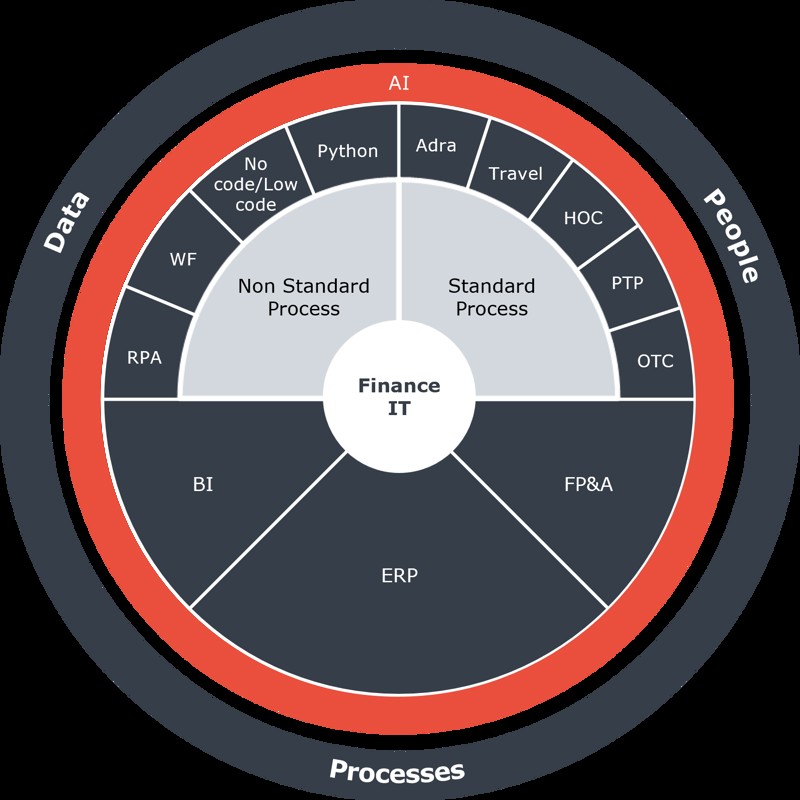The dawn of Generative AI (and ChatGPT in particular) as a popular term in 2023 and its rapid development into a viable technology opportunity means enterprises must adapt roadmaps, budgets and attention. Here we offer up our interpretation of the current wave of AI technology as well as a guide for how to approach it strategically for enterprise leaders.
Generative AI is everywhere. The emergence unto the scene of the technology with the public release of ChatGPT in November 2022 has spurred nothing less than a veritable hype storm:
it is the topic of board rooms, canteens, conferences, newspapers as well as dinner tables and family gatherings. It is becoming more of a popular trope than a meaningful means to transform our practices, with everybody increasingly asking what’s in a name and demanding tangible use cases and relevant frameworks for understanding the reality behind the publicity.
For an enterprise, the technology is stacked rather neatly into domains of interaction possibilities. And we believe, after all, that getting a grasp of how, where and why to interact with phenomena determines its relevance and applicability more than stories of unfathomable capabilities and tall tales of future massive disruptions.
As such, we have broken it down into four different layers of interaction: Capability platforms; Enterprise systems; 3rd party apps and Custom-tailored solutions.
Read along for a breakdown of the different layers of generative AI that will enable you to conceptually guide AI effort in your organization – and budget.
Capability Platforms
The enticing aspect of ChatGPT that caught almost everyone by surprise was the depth and especially width of its training. The November 2022 released version 3.0 was trained on roughly 45 terabytes of text data, while the newest model, 4.0, is trained on 1 petabyte. That is 1.000 terabytes. For comparison, the entire works of William Shakespeare would only occupy 5 megabytes, amounting to only 0,0000005% of the entire corpus.
Training a deep learning model that constantly contextualizes every word with the previous and following 100 words (as example) on a text corpus of this size requires resources quite out of reach for any normal sized enterprise.
And indeed, ChatGPT 4.0 was trained by OpenAI in collaboration with Microsoft, who made its massive cloud computing base available to OpenAI to perform the training – and still it took around 3,5 months to complete.
The result was a large set of General Pre-trained Transformers (GPT) that could predict in rapid succession the most plausible next word in almost any given text string. This is why it is able to produce cross-domain texts like rap lyrics about food recipes or Old Testament style musings on financial forecasts for modern enterprises. A model of this depth and width is commonly referred to as a Foundational Model, as opposed to a more narrow, functionalistic model trained on specific data.
ChatGPT is not alone here, but only one in a host of other providers of (almost) equal capabilities. As expected, while Microsoft is currently engaged to OpenAI, Google and Meta have on their own announced similar models, while Amazon in September 2023 announced a massive investment into a collaboration with Anthropic. Beyond these, there is also a number of smaller models and open-source alternatives, as well as generative models for image, music, protein folding and other non-text based generative AI models.
What is your opportunity?
As the technology can create almost anything, the key skill needed to exploit the technology is the ability to ask adequate questions to achieve your goal.
As the technology can create almost anything, the key skill needed to exploit the technology is the ability to ask adequate questions to achieve your goal. Ensuring your organization is ready and skilled to both understand the possibilities and limitations of the models and interact with them is crucial.
Ensuring your organization is ready and skilled to both understand the possibilities and limitations of the models and interact with them is crucial.
Introducing your organization to the technology and the foundational models as well as teaching your employees how to utilize their powers will be essential to adoption, opportunity creation and impact.
Enterprise Systems
When even your grandparents have heard of the technology, chances are that the largest enterprise system providers have too.
In the long run, Generative AI technology will proliferate through our common enterprise system landscape, becoming an inherent capability of the SAPs, Salesforces and Dynamics suites of the world.
Every serious enterprise system suite already has it on its roadmap and some of them have already released generative AI technology functionality that utilizes market foundational models – in most cases by buying the pre-trained models and implementing them into their own base technology.
Enterprise systems are designed to cover the needs of entire industry verticals or horizontal functions and are in essence best practice proliferators. An example of this is how you in an ERP, do not need to design an accounts payable function on your own, as the system already has at least a lowest common denominator setup for handling this.
The differentiator for these systems is how able they are at not necessarily leading the practice they serve but delivering best practice enabling functions.
And as generative AI proliferates and matures, it will most certainly come to redefine best practice in the short term before eventually becoming a standard and lowest common denominator functionality in enterprise systems further down the road.
What is your opportunity?
For the functions not decidedly novel to your company, or the tasks you perform that are not a key differentiator to your market position, chances are your needs will be covered by the enterprise system layer.
The imperative here is – and we cannot stress this enough – to ensure you have modernized your core application landscape to enable you to benefit from the latest (generative AI enabled) updates.
Likewise, dedicating time and resources to participating in conferences, product update webinars and network meetings are essential to stay on top of the technology and in parallel make sure you are reaping the maximum benefits of your application landscape.
Likewise, dedicating time and resources to participating in conferences, product update webinars and network meetings are essential to stay on top of the technology and in parallel make sure you are reaping the maximum benefits of your application landscape.
3rd Party Apps
Modern enterprise application architecture is like a solar system, with huge monolithic applications accompanied, supplemented and connected by lesser functionalistic applications. Many if not most of the hitherto monolithic and slowly changed applications have even adopted this trend and become application suites.
This means they both incorporate and develop diverse border capabilities themselves, but also that they are often accompanied by an app marketplace, where developers build apps directly compatible with the core application.
This way, the previously best practice approach is broadened to cater to specific niche industry specific requirements for instance, or to horizontal capabilities that connect functions beyond the typical.
Likewise, this suite and marketplace architecture is more often than not also a primary driver of innovation for many of these large application providers, as they can see from marketplace consumption which external apps are most successful and thus what functionality they should be looking to build or acquire to include in their core offering.
These add-ons are called 3rd party apps, and they are everywhere. A quick glance at the Microsoft AppSource marketplace for compliance and legal apps reveal more than 1400 applications at present. Naturally, this is also where the first generative AI applications emerged as soon as direct API access to open models like ChatGPT were enabled.
But the space for 3rd party apps for generative AI capabilities is… troubled at the moment.
'A lot of the first movers in this space were, as mentioned, utilizing an open API to models that everyone could utilize, often adding some extra capabilities or business logics to the raw power of the foundational model.
But many of them are rapidly getting disrupted by both increasing capabilities on the part of the foundational model providers themselves as well as by the roadmaps and developments in the enterprise systems layer.
A notable cautionary tale is generative AI firstmover startup Jasper.ai, who in June 2023 raised money at a value of 1,5 bn USD, but already end of September had to cut this value by 20% as growth had completely stalled. The reason? It was relying on OpenAI technology to power its product but was now being outcompeted by OpenAI itself.
This means that any 3rd party app that utilizes generative AI to provide something akin to groundbreaking solutions should be scrutinized closely for more than just its use of the technology.
What is your opportunity?
For 3rd party apps, the opportunity remains rather the same as always – look at the business value they offer and evaluate their specific domain capabilities to ensure they cater to your needs and way of working.
The caution, however, has to be to remain extra vigilant when purchasing software that is primarily driven by AI capabilities or who is putting all their research and development into AI features.
For 3rd party apps, the opportunity remains rather the same as always – look at the business value they offer and evaluate their specific domain capabilities to ensure they cater to your needs and way of working. The caution, however, has to be to remain extra vigilant when purchasing software that is primarily driven by AI capabilities or who is putting all their research and development into AI features.
While you should expect all of your applications to be AI ready and have it in their roadmaps, that same AI requirement is a double edged sword as the AI market is evolving so rapidly at the moment.
The big fear is that you will acquire, implement and train your employees on a tool that is out of business in 6 months, while the smaller caution is that you will invest in a tool for AI capabilities that are obsolete in a heartbeat.
The rule of thumb: look at all the other capabilities of the app, its internal logics and workflows and steer relatively clear of getting fazed by generative AI.
Custom Solutions
Sometimes best practice just doesn’t cut it, and often we can’t wait for updates to solve a critical problem.
This implies that more often than not, digital headaches are lonely headaches. In a slight paraphrasing of the opening phrase of Anna Karenina by Tolstoy, “every happily digitalized company is alike; every unhappy un-digitalized company is unhappy un-digitalized in its own way”.
And even though we could easily wait for an update to SAP to deepen our controlling ability, the estimated savings from this increased controlling makes it more than worthwhile to get it done immediately, even as a temporary measure.
As the foundational models of the capability platforms are mostly available directly through API calls or can be deployed directly within your own Azure environment like ChatGPT, it is very possible and relatively technically straightforward to infuse every custom solution with generative AI.
Revisiting old and rejected use cases for automation have never been more rewarding.
During the RPA wave of previous years, it was always ever only possible to automate structured, digital data. Generative AI has the capability to go beyond this, as it can both generate as well as interpret unstructured data. And through sensory mechanisms (like a camera) it is a subsequently able to automate the non-digital, effectively bridging the analogue-digital chasm and opening up entirely new possibilities for enterprise automation.
What is your opportunity?
If you still have the heatmaps from previous digitalization forays, now is the time to dig them out of oblivion.
In addition, there is gold and longevity to be found in identifying the automation opportunities in the processes that support your market differentiation. These processes are in theory not likely to be covered by other systems or even 3rd party apps and does therefor represent opportunities for real lasting innovation.
The readiest application of the technology is the possibility to tweak the models though programmatic prompt engineering and fine tuning into becoming a tailored assistant for different departments.
An example of this could be setting up an AI assistant that looks through previous invoices to propose a response to a customer enquiry in your accounts receivable department.
Furthermore, the general availability of the technology through APIs and private deployments mean that it is very possible to build solutions that utilize the technology – this could be done by incorporating it into automations and apps that can help you spur innovative developments previously impossible to create.
The bottom line
Generative AI is swiftly becoming a cornerstone of enterprise innovation, necessitating a strategic approach to integration across various operational layers.
Generative AI's rapid ascent calls for a strategic focus to ensure that enterprises do not squander time, energy, or budget. A discerning approach to adoption is essential to harness its potential without being sidetracked by the technology's hype, ensuring meaningful and efficient integration into business processes and practices.
Organizations must focus on mastering prompt engineering to effectively utilize foundational models and ensure their enterprise systems are modernized and agile enough to incorporate AI advancements.
As the technology evolves, it's crucial to critically assess third-party apps and explore custom solutions that offer competitive differentiation and address unique business challenges.
Generative AI's rapid ascent calls for a strategic focus to ensure that enterprises do not squander time, energy, or budget.
A discerning approach to adoption is essential to harness its potential without being sidetracked by the technology's hype, ensuring meaningful and efficient integration into business processes and practices.
Competences – full-circle
When helping a Finance function digitalise and automate, we take pride in combining the applications and tools that will meet your specific demands. In a way so that the solution supports the data, processes and people working hard behind the lines.

Basico's digitalisation circle

Do you need help implementing the right AI tools in your company?
At Basico we can help you transform your business support functions with AI technology. We know the pain points across business support, and we know the traps and rewards in automation and implementation.
Reach out to learn more about how we can help you make AI transform your operations.

 en
en
 da
da



